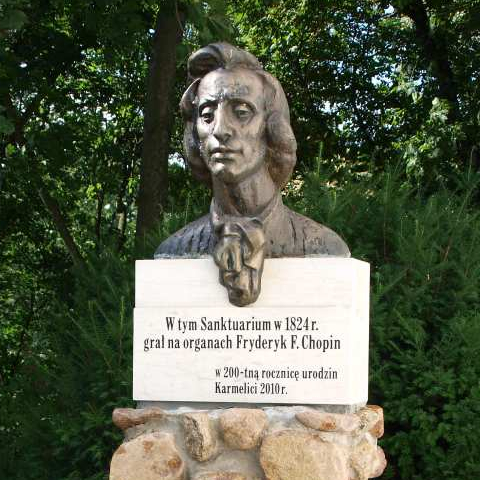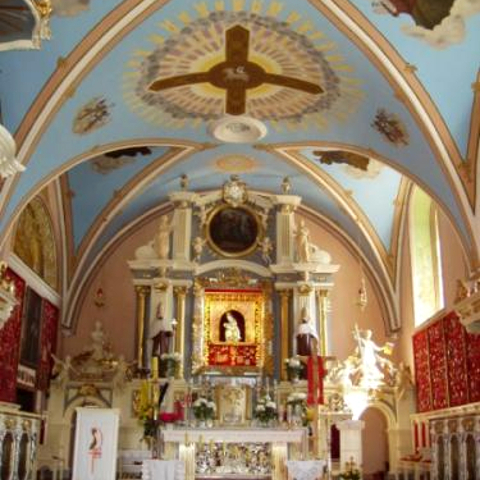Composers / Fryderyk Chopin / Places catalog
Obory
The Discalced Carmelites monastery complex and the Church of the Visitation of Our Lady, founded in 1605 by the then owners of the land, Łukasz and Anna Rudzowski, were erected on an elevated area formerly known as Grodzisko in the centre of Obory. Unfortunately, the wooden buildings burnt down in 1617. The now widowed Anna Rudzowska decided to bequeath part of her fortune to the Carmelites, on condition that they rebuild the church and the monastery. The church and monastery that stand there now were completed in the middle of the eighteenth century. The distinctive 45-metre-high clock tower dates from the same period.
The Gothic Pietà was carved from linden wood at the turn of the fifteenth century. It is an especially valuable object and is venerated by the faithful. The sculpture originally belonged to a monastery in Bydgoszcz, from where the Carmelites were invited to Obory by the Rudzowskis. The figurine of Our Lady of Sorrows was probably already there in 1605.
The Dziewanowski family had a special connection with the Sanctuary of Our Lady of Sorrows in Obory. Juliusz Dziewanowski, the great-grandfather of Chopin’s school friend Dominik, had a side chapel of Divine Providence built against the south wall of the church in 1740 as a token of gratitude for the miraculous recovery of his child. Dziewanowski also supported the sanctuary financially for many years. The parents of Dominik’s father’s second wife, Honorata Dziewanowska, née Borzewska, similarly supported the Obory church financially and were buried in the crypt (their epitaph is still there, on the altar of St Joseph).
Although there are no primary sources to confirm that Chopin ever visited the Obory sanctuary, it is safe to assume that he had the opportunity to do so, courtesy of Dominik’s parents, as it is only 16 km from Szafarnia.
According to one uncorroborated account, Chopin played the organ in the Obory church. The young Chopin must have been a consummate organist, as a year later, in the autumn of 1825, he was appointed organist of the Visitandines' church on ul. Krakowskie Przedmieście, where he played for masses celebrated for the school children.
Chopin wrote letters home from Szafarnia in the form of a newspaper, which he titled “Kuryer Szafarski” [Szafarnia courier]. In one of these, he ‘reported’ a humorous story that he had heard concerning Obory: ‘A certain citizen of the environs wished to read The Monitor. So he sent a servant to the Carmelite Fathers in Obory to ask for periodicals. Since the servant had never heard of periodicals in his life, he twisted the expression and asked the Fathers for haemorrhoidals’.
On 9 October 1999, a plaque commemorating Chopin’s stay in Obory in the summer of 1824 was unveiled in the vestibule of the church to mark the 150th anniversary of the composer’s death. In 2010, a bronze bust of Chopin, financed by the Carmelites, was placed between the church and the courtyard of the monastery to mark the bicentenary of his birth.
The area around Obory is known as the ‘Dobrzyń Switzerland’, on account of its varied terrain.
-

Carmelite Church in Obory. Phot. NIFC.
-

Chopin monument. Phot. Kazimierz Stawicki.
-

Interior of Carmelite Church. Phot. NIFC.